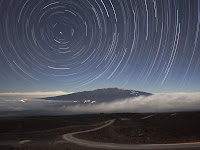 Taurus the Bull is easy to identify even in light polluted skies. Orion's belt stars make good pointers. Connect the three dots and continue the line of sight up and to the right and you will arrive at a small "V" shape of stars. That is Taurus' face. The brightest star in the "V" is the Bull's Eye, a red giant called Aldebaran. Aldebaran means "the follower," but what is it following? If you continue the line from Orion's belt through the "V" you will see. The Seven Sisters (or Pleiades) is just to the west. As the night goes on Aldebaran follows the Sisters through the sky.
Taurus the Bull is easy to identify even in light polluted skies. Orion's belt stars make good pointers. Connect the three dots and continue the line of sight up and to the right and you will arrive at a small "V" shape of stars. That is Taurus' face. The brightest star in the "V" is the Bull's Eye, a red giant called Aldebaran. Aldebaran means "the follower," but what is it following? If you continue the line from Orion's belt through the "V" you will see. The Seven Sisters (or Pleiades) is just to the west. As the night goes on Aldebaran follows the Sisters through the sky..
Inside the "V" are a lot of stars. This is called the Hyades star cluster (in Greek mythology five of these were the half-sisters to the Pleiades) ((wait a second... seven plus five... that's a lot of kids for the god Atlas to raise!). The Hyades are the closest open cluster to Earth at only 150 light years distant. You can observe dozens to hundreds of these stars with a good pair of binoculars. Aldebaran is not a Hyade, though. It is much closer to the Earth and just appears in the same neighborhood.
.
Off the top
 of the "V", the horns of the bull radiate out to the stars Elnath and Zeta Tauri. Next to Zeta Tauri is one of the most interesting objects in space. Named M1 or the Crab Nebula, this is the remnant of one of the brightest stellar explosions ever witnessed by humans. M1 is the leftover of a supernova explosion that erupted in 1054 AD. The blast was so bright that it was visible during the daytime along with the Sun. Since then we've had two other bright supernovas (1572 and 1604). I think we're due. And maybe, fingers crossed, we'll see Betelgeuse go "KABLOOEY!"
of the "V", the horns of the bull radiate out to the stars Elnath and Zeta Tauri. Next to Zeta Tauri is one of the most interesting objects in space. Named M1 or the Crab Nebula, this is the remnant of one of the brightest stellar explosions ever witnessed by humans. M1 is the leftover of a supernova explosion that erupted in 1054 AD. The blast was so bright that it was visible during the daytime along with the Sun. Since then we've had two other bright supernovas (1572 and 1604). I think we're due. And maybe, fingers crossed, we'll see Betelgeuse go "KABLOOEY!"
-























































